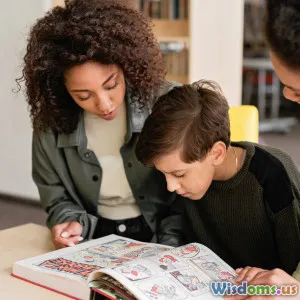
The Evolution of Inclusive Storytelling
7 min read Explore the transformative journey of inclusive storytelling in literature, highlighting milestones and its impact on readers worldwide. (0 Reviews)
The Evolution of Inclusive Storytelling
Storytelling has long been a fundamental mode of human connection, a vessel for culture, knowledge, and identity. Yet, for centuries, the dominant narratives in literature often sidelined or erased marginalized voices. As the world grows more interconnected and society embraces diversity, the evolution of inclusive storytelling has emerged as both a necessary cultural revolution and an enriching journey. This article explores the profound transformation in literature that champions representation and inclusivity, illustrating how such storytelling reshapes readers’ perspectives and broadens the literary landscape.
The Historical Landscape of Storytelling
Historically, canonical literature largely reflected the experiences, identities, and worldviews of dominant groups—primarily white, male, Western authors. The celebrated classics from Shakespeare to Dickens echoed this predisposition. Meanwhile, voices of minority racial groups, women, LGBTQ+ individuals, and people with disabilities were either marginalized or stereotyped.
For example, early literature often portrayed people of color through reductive tropes rather than fully fleshed characters. Harriet Beecher Stowe’s Uncle Tom’s Cabin (1852), although groundbreaking in anti-slavery advocacy, still contained problematic depictions from a modern viewpoint. Moreover, women’s narratives were frequently limited to domestic concerns or romantic archetypes, as seen in much of 19th-century fiction.
Seeds of Change: Early Advocates and Pioneers
The 20th century marked the beginning of a bolder quest for marginalized voices to appear authentically in literature. Writers such as Zora Neale Hurston, James Baldwin, and Toni Morrison challenged dominant narratives by weaving rich cultural and personal histories into their works. Baldwin’s Go Tell It on the Mountain (1953) vividly portrayed African American life confronting issues of identity and spirituality. Morrison’s Beloved (1987) delved into traumatic legacies of slavery with poetic empathy.
In parallel, feminist literature reshaped women’s storytelling. Virginia Woolf’s essays, especially A Room of One’s Own (1929), advocated for women’s autonomy in creating narratives and controlling their legacies. LGBTQ+ literature also began emerging, with authors such as James Baldwin and Audre Lorde who addressed queer identity in subtle and poignant ways amidst cultural repression.
The Rise of Intersectionality and Diverse Narratives
The late 20th and early 21st centuries witnessed the rise of intersectional approaches to storytelling—acknowledging that identity comprises multiple, overlapping categories such as race, gender, sexuality, disability, and class.
Consider pioneers like Chimamanda Ngozi Adichie, whose works like Americanah (2013) intricately map themes of race, immigration, and cultural conflict. Or Angie Thomas’s The Hate U Give (2017), a young adult novel that puts at its center a Black teenager navigating police violence and systemic racism.
Data from publishing houses illustrate this growth. According to the Cooperative Children’s Book Center’s 2019 survey, books by or about people of color reached a historic high, signaling increased demand and supply of diverse literature.
Inclusive Storytelling’s Impact on Readers and Society
Inclusive literature transcends mere representation—it fosters empathy, broadens cultural understanding, and empowers underrepresented communities. Scholar Rudine Sims Bishop describes diverse books as "windows, mirrors, and sliding glass doors"—offering readers opportunities to see themselves reflected, understand others, and experience different realities.
Research supports these benefits. A 2013 study in Reading Research Quarterly found students exposed to diverse literature showed increased empathy and open-mindedness. Young people from marginalized groups especially benefit from access to texts validating their experiences, combating feelings of isolation or invisibility.
The Role of Technology and the Future of Inclusive Storytelling
Digital platforms, independent presses, and social media have democratized storytelling, amplifying marginalized voices outside traditional gatekeeping institutions.
Crowdfunding and self-publishing have enabled authors like R.F. Kuang and Dhonielle Clayton to connect directly with eager audiences seeking inclusive narratives. Additionally, initiatives like We Need Diverse Books and literary awards focused on diverse voices incentivize both publishers and authors.
Looking ahead, inclusive storytelling increasingly intersects with other media like graphic novels, podcasts, and interactive fiction, further expanding and engaging contemporary audiences.
Conclusion: Embracing Storytelling as a Tool for Social Change
The evolution of inclusive storytelling reflects literature’s dynamic role as a mirror to society and an agent of transformation. Moving beyond tokenism, today’s inclusive narratives demand authenticity, complexity, and respect for diverse lived realities.
By embracing stories that represent the full spectrum of human experience, readers and writers alike participate in building a more empathetic and just world. The journey is ongoing, but the literary landscape is richer and more vibrant because of it. Engaging with inclusive storytelling is thus not only an artistic enrichment but a vital social imperative.
References:
- Bishop, Rudine Sims. “Windows, Mirrors, and Sliding Glass Doors.” Perspectives, 1990.
- Cooperative Children’s Book Center (CCBC). 2019 Statistical Summary.
- Woolf, Virginia. A Room of One’s Own. 1929.
- Baldwin, James. Go Tell It on the Mountain. 1953.
- Morrison, Toni. Beloved. 1987.
- Thomas, Angie. The Hate U Give. 2017.
Inclusive storytelling has revolutionized literature and offers readers new vistas of understanding. What story will your life tell next? Feel empowered to amplify voices that broaden the human narrative.
Rate the Post
User Reviews
Popular Posts





















